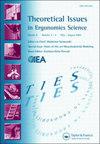Development and validation of a tool for the comprehensive risk assessment of musculoskeletal disorders (CRAMUD) among employees of a steel industry
IF 1.4
Q4 ERGONOMICS
引用次数: 0
Abstract
Abstract This study aimed to develop and validate a tool for the comprehensive risk assessment of musculoskeletal disorders (CRAMUD). In this cross-sectional study, 300 male workers participated. Data related to personal, psychosocial and physical items and musculoskeletal symptoms were gathered by a designed questionnaire and Cornell musculoskeletal discomfort questionnaire (CMDQ), respectively. Then, the effect coefficients of the items were computed for developing the CRAMUD equation. The total score of the CRAMUD tool was classified by receiver operator curves (ROCs), and it was validated by linear regression analysis. The values of the content validity ratio (CVR), content validity index (CVI) and Cronbach’s coefficient alpha (α) of the CRAMUD questionnaire with 38 items were calculated as 0.773, 0.934 and 0.940, respectively. The personal, psychosocial and physical items with the coefficients of 0.265, 0.175 and 0.478 had significant effects on the occurrence of musculoskeletal symptoms, respectively. The equation of the novel tool was written by these coefficients. The CRAMUD score was grouped into four levels by optimal cut-off points of 8.51, 11.03 and 15.31. This tool could predict 75% of variations of musculoskeletal symptoms. This tool can be exploited to accurately estimate the risk level of musculoskeletal symptoms in various jobs.钢铁行业员工肌肉骨骼疾病(CRAMUD)综合风险评估工具的开发和验证
本研究旨在开发和验证一种用于肌肉骨骼疾病(CRAMUD)综合风险评估的工具。在这项横断面研究中,有300名男性工人参与。通过设计问卷和康奈尔肌肉骨骼不适问卷(CMDQ)收集与个人、社会心理和身体项目以及肌肉骨骼症状相关的数据。然后,计算各项目的影响系数,建立CRAMUD方程。采用接收算子曲线(roc)对CRAMUD工具的总分进行分类,并进行线性回归分析。计算38项CRAMUD问卷的内容效度比(CVR)、内容效度指数(CVI)和Cronbach’s系数α (α)分别为0.773、0.934和0.940。个人、社会心理和身体项目对肌肉骨骼症状的发生影响显著,其系数分别为0.265、0.175和0.478。新型刀具的方程由这些系数组成。CRAMUD评分按最佳截止点8.51、11.03和15.31分为4个等级。这个工具可以预测75%的肌肉骨骼症状的变化。该工具可用于准确估计各种工作中肌肉骨骼症状的风险水平。
本文章由计算机程序翻译,如有差异,请以英文原文为准。
求助全文
约1分钟内获得全文
求助全文

 求助内容:
求助内容: 应助结果提醒方式:
应助结果提醒方式:


